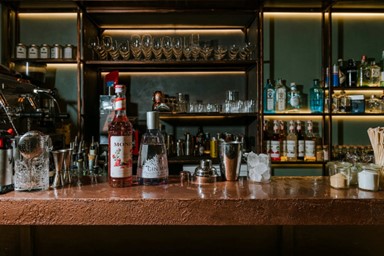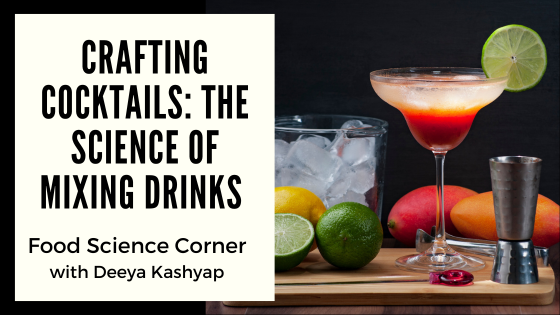Crafting Cocktails: The Science of Mixing Drinks
Last Updated on February 27, 2024
Let’s talk about alcohol!
People have varied opinions and preferences when it comes to alcohol. Some are extremely attracted to it, some manage it moderately, and others want nothing to do with it. Humans have consumed alcohol in various ways over centuries. To date, it is one of the most common beverages for social bonding. Our predecessors gave us wine, beer, and so on, from experimenting with fermentation of fruits, vegetables, and cereals.
The latest development in our history with alcohol is the addition of cocktails, a mixture of alcohol and fruit juices, syrups, tonic water, sweeteners, herbs, or bitters, among others. Currently ‘cocktails in a can’ are sold in ready-to-drink fashion in the market, with increasing demand. With this growing popularity of cocktails, the science of mixology has also evolved.
Mixology
Mixology is the art of preparing mixed drinks. This is different from bartending in that it is the science of using techniques to create unique combinations of cocktails. A mixologist may or may not work behind the bar, although both the titles are used interchangeably.
Tools used in mixology
Although there are various tools used in mixing cocktails, there are some which are considered essential:
- Jigger- This is an hourglass-shaped stainless steel measuring tool for measuring 3/4th ounces and 1 ½ ounces.
- Shaker – There are two main types of shakers – the Boston shaker which is a two-part shaker comprising a pint glass and a metal lid. The other type is a Cobbler shaker, a three-part shaker made of a mixing tin, cap with a built-in strainer and a lid.
- Muddler – A stainless steel or wooden stick used to mash herbs or fruits.
- Bar Spoon – This is a long stirring spoon, with a twisted shaft.
- Strainer – A strainer is used to pour out a liquid cocktail after mixing, leaving unwanted solids behind.
- Blender – Used in frozen drinks, for crushing ice.

Mixing Techniques
Some techniques to create unique blends and mixes of drinks are:
- Layering drinks – Used with ingredients of varying densities to create a unique presentation.
- Muddling drinks – Fruits and other ingredients are crushed in the drink to add freshness and flavor to the cocktail.
- Rolling drinks – A method of gently mixing drinks rather than shaking them, by moving them from one vessel to another.
- Use of ice – Ice is essential for chilling the drink and for slightly diluting it.
- Garnishing drinks – Garnishes enhance the presentation of a cocktail and elevate their flavor. These can accentuate clear alcoholic beverages.
Molecular mixology
Tools used in molecular mixology
Molecular mixology comprises mostly of the same tools for mixing drinks, mentioned above. There are some different ones which are worth mentioning:

Techniques of Molecular Mixology
- Spherification – It involves creating small balls of liquid that burst in your mouth, releasing the encompassed flavor. These can be added to cocktails as a visual novelty and for an extra pop of flavor. There are two methods of creating spheres.
- Sodium alginate can be used to create different sizes of spheres. One popular way to do this by creating big spheres resembling egg yolks with sodium alginate and calcium lactate. Alginate is found in natural sources like seaweed. It is a type of polysaccharide with the ability to thicken liquids. In the presence of calcium ions alginate can form large gel networks which restrict the movement of molecules. When the beverage containing sodium alginate is dipped into the calcium lactate solution, this gel- like network is formed as a layer, creating a shape and texture like an egg yolk.
- The other method of spherification is to make smaller spheres resembling caviar. This can be done using agar agar and cold oil. The hot agar agar is added to the desired beverage and while it’s still liquid, it is added to cold oil using a dropper. Small spheres are thus formed.
- Foaming – In foaming, gases are dispersed in liquids or solids such as in cocktails like gin fizz or amaretto sour. In these examples, foaming is done by whisking, blending or dry shaking (shaking the beverage without ice) egg whites with lemon juice to create stable foam. Dry shaking is best for creating a foam as egg white foams form much more efficiently at room temperature than when chilled. Apart from thick foam using eggs, light foam can also be created using soy lecithin in powdered form.
- Suspension – This is the technique of thickening liquids in beverages, usually with xanthan gum to allow objects, such as caviar spheres or fruit to float or suspend in the beverage.
- Smoking – Smoking involves infusing a cocktail with smoke to add a unique flavor and aroma. A device called a smoker box containing wood chips in water is used for smoking. The cocktail is then placed inside the box, the chips are lit on fire and smoke is infused into the cocktail. Various flavors of smoke can be derived from using different sources of wood chips. Generally, fruity smokiness or a nutty, earthy smokiness is infused in the cocktail.
Enjoy Responsibly
This article may make you want to go out and explore the latest molecular mixology trends for yourself. Please remember to drink responsibly.

Bibliography
- Murphy, J. P. (2010). Molecular Mixology: the New Frontier for Cocktails.
- The Science of Cocktails: A Guide to Molecular Mixology
- Molecular Gastronomy Cocktails by Lior S5
- Mixology 101: A Beginner’s Guide To Cocktails by Saucy
- How to Light Flaming Shots by Thrillist
- Cocktails by Wikipedia


leave your comment